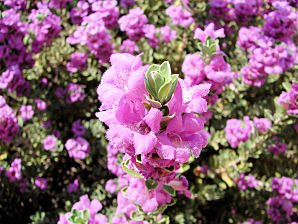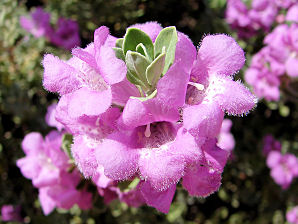Xeriscape Landscaping Plants For The Arizona Desert Environment.
Pictures, Photos, Information, Descriptions,
Images, & Reviews.
Shrubs.
Texas Sage, Leucophyllum frutescens.
We Are Proud Of Our SafeSurf Rating!
Click On Any Of The Following Links By Amazon.Com
For Books, & Videos About Wildflowers Of Arizona & The Southwest USA. No Obligation!
 |
| Texas Sage, Leucophyllum frutescens. August 23, 2006. Hillcrest Ranch, Glendale, Arizona. |
|---|
 |  |
| Texas Sage. Leucophyllum frutescens. | Texas Sage. Leucophyllum frutescens. |
|---|---|
 |  |
| Texas Sage. Leucophyllum frutescens. | Texas Sage. Leucophyllum frutescens. |
 /
/

Texas Sage.
We wish to thank Wikipedia, the free encyclopedia for some of the information on this page. We share images and information with Wikipedia. Considered to be one of the strongest shrubs around, Texas sage (sometimes called "Purple sage") can face droughts, freezes, high winds, salt spray, hungry deer, and full Arizona summer sunlight and will still remain beautiful. are generally disease and pest-free. They tolerate Arizona alkaline well-drained soils. The most common Texas sage has small gray-green leaves and lavender blossoms during the summer. It's abundant flower display and silver foliage makes this plant a fine addition to any southwestern landscape. It is best used as a border or low screen, is also a good accent plant in perennial/wildflower beds. It flowers greatly during the summer monsoons.
Quick Notes:
Height: 5 - 8 feet tall, spread 4 to 6 feet.
Flowers: Five-lobed tubular 1/2 - 1 inch flowers covering the plants with white, pink, lavender, purple, or blue blossoms.
Blooming Time: Late February - March. Again during the monsoon rains in Arizona.
Leaves: Leaves have a silver pubescence and an attractive felty touch. The leaves are wavy, oval, and 1/2 - 1 inch alternating leaves.
Found: The USDA claims Leucophyllum frutescens is native to the USA (TX). It is also native to Mexico in Chihuahua, Coahuila, Nuevo Leon, & Tamaulipas.
Elevation: Native from 400 - 2,500 feet.
Hardiness:
Soil pH requirements:
Sun Exposure:
Habitat: Alkaline, well-drained/light soils. An ideal landscape plant in Arizona.
Miscellaneous: Flowering Photos Taken August 23, 2006. Hillcrest Ranch, Glendale, Arizona. Water slightly in Phoenix. Does best without fertilizer.
|



We Are Proud Of Our SafeSurf Rating!
Click On Any Of The Following Links By Amazon.Com
For Books, & Videos About Xerioscape Plants Of Arizona & The Southwest USA. No Obligation!
Back To Arizona Xeriscape Landscaping Main Page.
Back To Xeriscape Shrubs Page Three.
Back To Arizona Wild Flowers Home Page
Back To DeLange Home Page
© 1966 - Present, Audrey, Eve, & George DeLange
| © 1966 - Present, Audrey, Eve, & George DeLange |


